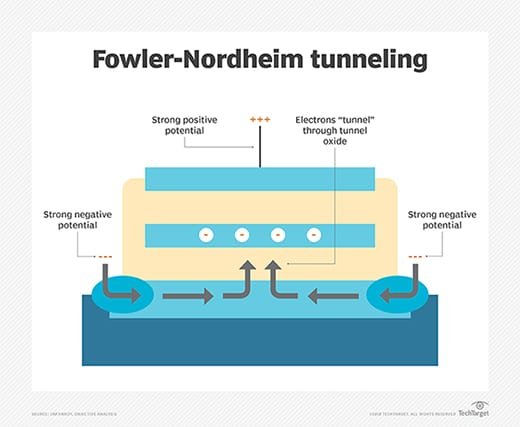
floating gate transistor (FGT)
What is a floating gate transistor (FGT)?
A floating gate transistor (FGT), also known as a floating gate MOSFET, is a complementary metal-oxide semiconductor (CMOS) technology capable of holding an electrical charge in a memory device that is used to store data.
Floating gate transistors were first used in erasable programmable read-only memory (EPROM) and later in electronically erasable programmable read-only memory (EEPROM). Flash memory is a type of EEPROM that is programmed and erased in large blocks.
The flash chip's cells are arranged in a grid that has a transistor at each intersection. Each transistor has two gates: One is known as a floating gate, and the other one is called a control gate. The two gates are separated from each other by a thin dielectric material generally referred to as the oxide layer. Because the floating gate is electrically isolated by the oxide layer, any electrons placed on it are trapped there. This is what makes flash memory non-volatile.
How floating gate transistors work
Flash memory works by adding (charging) or removing (discharging) electrons to and from a floating gate. A bit's 0 or 1 state depends upon whether or not the floating gate is charged or uncharged. When electrons are present on the floating gate, current can't flow through the transistor, and the bit state is 0. This is the normal state for a floating gate transistor when a bit is programmed. When electrons are removed from the floating gate, the current is enabled to flow, and the bit state is 1.
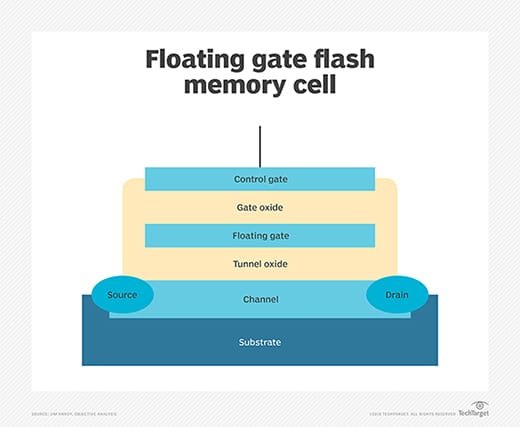
Two options are used to add, or trap, electrons in the floating gate:
- Fowler-Nordheim tunneling requires a strong electric field between the negatively charged source and the positively charged control gate to draw electrons into the floating gate. The electrons move from the source through the thin oxide layer to the floating gate, where they are trapped between the oxide insulation layers.
![how fowler-nordheim tunneling works]()
A strong electric field between the negative source and positive control gate is necessary for Fowler-Nordheim tunneling to bring electrons into the floating gate. - Channel hot electron injection, also known as a hot-carrier injection, uses a high current in the channel to give electrons sufficient energy to "boil" out of the channel and break through the tunnel oxide layer, changing the threshold voltage of the floating gate. A positive charge on the control gate attracts the electrons from the channel into the floating gate, where they become trapped.
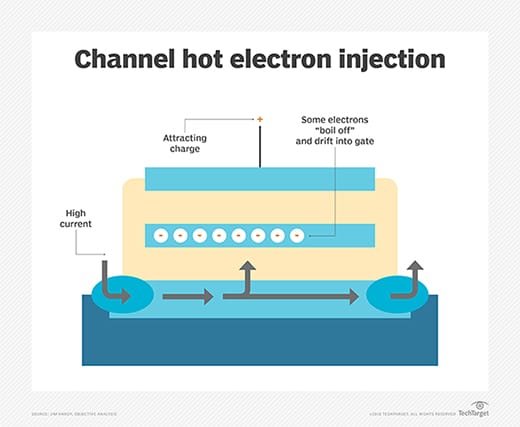
The oxide layer that surrounds the floating gate keeps the electrons trapped, whether or not the flash device has power, enabling persistent storage of data bits.
Two mechanisms are also used to remove the electrons from the floating gate. With EPROM technology, exposing the memory cell to ultraviolet light causes the electrons to leak out of the floating gate. In EEPROM and flash memory devices, Fowler-Nordheim tunneling removes electrons from the floating gate. A strong negative charge on the control gate forces electrons through the tunnel oxide layer into the channel, where the electrons are drawn to the strong positive charge at the source and the drain.
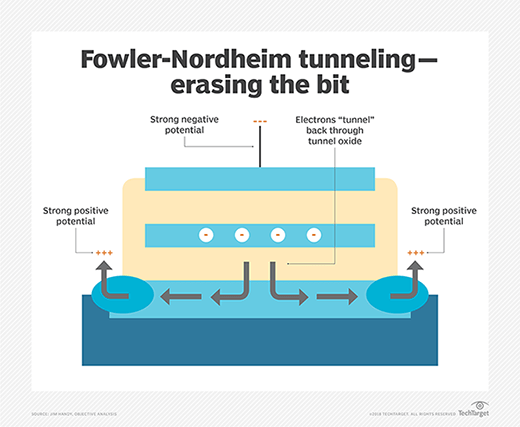
Benefits of floating gate transistors
Floating gate transistors have found widespread applications in various memory storage technologies, including EEPROM, flash memory technology and other non-volatile memory options.
The following are the main benefits of using floating gate transistors:
- Ability to retain data. The main advantage of floating gate transistors is their ability to retain data even when the power supply is disconnected. Because floating gate transistors are non-volatile, they are perfect for applications requiring persistent data storage, such as memory cards, USB drives, solid-state drives and embedded systems.
- High-density storage. Floating gate transistors have data-storing capabilities, which enable the construction of compact memory devices with high storage capacitance. They also have good endurance and enable a high number of program/erase cycles, which makes them suitable for long-term use.
- Lower power consumption. Floating gate transistors are energy-efficient because they require relatively little power to store data. This is especially important for portable devices since it contributes to longer battery life.
- Fast read/write. Floating gate transistors are perfect for use in devices that require fast memory access, such as computer hard drives, because they can be programmed and read quickly.
Floating gate vs. charge trap
A floating gate and a charge trap are types of semiconductor technology capable of holding an electrical charge in a flash memory device. But the chemical composition of their storage layers differs, and they add and remove electrons in different ways.
The following are a few characteristics and differences between floating gate transistors and charge traps:
- Flash devices that use floating gate transistors in the memory cells store electrons in an isolated polycrystalline silicon conductive layer. The charge of the floating gate changes when electrons are programmed into it to create a threshold voltage shift in the transistor.
- Devices that use charge trap technology typically store electrons in a nonconductive silicon nitride insulation layer. Forcing electrons into the nitride layer also generates a threshold voltage shift, and the electrons are held captive in the nonconductive material.
- Flash devices that use charge trap technology tend to be less complicated to manufacture than those that use floating gate transistors.
- Charge trap devices generally require low power to program and fewer process steps, and they are less prone to wear out because the programming operation puts less stress on the oxide layer. However, manufacturers have faced challenges in the mass production of NAND flash memory devices that use charge trap technology. The method used to remove electrons from a charge trap can be tricky, and data retention may be an issue in charge trap-based flash devices.
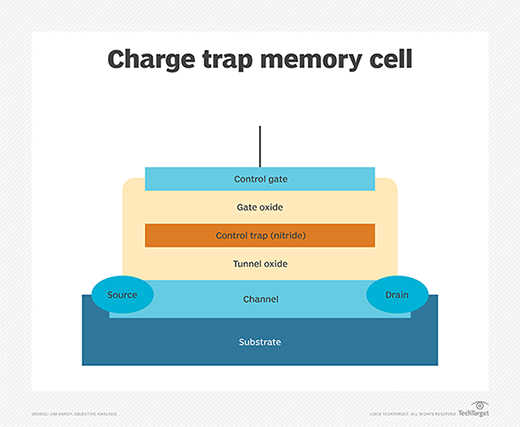
Advanced Micro Devices Inc. and Fujitsu Semiconductor Ltd. were pioneers in the volume production of charge trap technology in NOR flash memory devices. Spansion Inc. acquired Fujitsu Semiconductor's microcontroller and analog business in 2013, and Cypress Semiconductor Corp. subsequently merged with Spansion in 2015. Macronix uses charge trap technology in the production of read-only memory devices. NAND flash memory manufacturers, such as Samsung, SK Hynix and Toshiba, use charge trap technology in the manufacture of 3D NAND flash.
Intel and Micron continue to use floating gate transistors with their 3D NAND technology.
By taking advantage of the latest storage technologies, organizations can fulfill their data storage requirements efficiently. Discover the top five data storage trends that offer flexible, high-performance and economical storage options.
